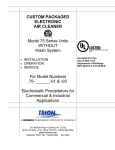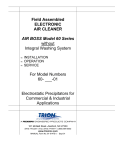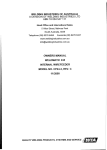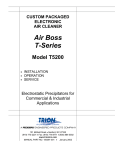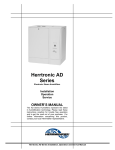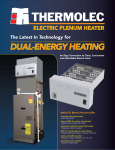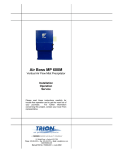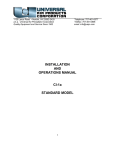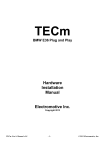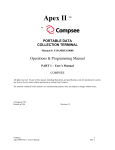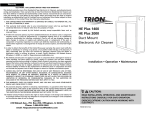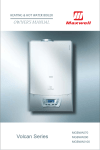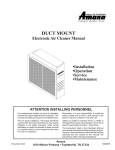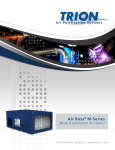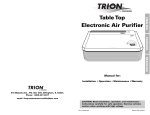Download Trion Air Compressor Air Boss ATS User's Manual
Transcript
Air Boss ATS (Air Treatment Systems) ATS SERIES • • • INSTALLATION OPERATION SERVICE Electrostatic Precipitators for Commercial & Industrial Applications 101 McNeill Road • Sanford, NC 27330 (919) 775-2201 • Fax: (919) 774-8771 (800) 884-0002 www.trioninc.com MANUAL PART NO. 147207-001 • December 2002 TABLE OF CONTENTS SECTION I DESIGN For The System Design Engineer Page 1. Introduction ................................................................................................................................ 1 2. General Description ................................................................................................................... 1 3. System Design and Layout........................................................................................................ 2 SECTION II INSTALLATION For The Installing Contractor 1. Unpack and Inspect ................................................................................................................... 3 2. Position Air Cleaner Cabinet ..................................................................................................... 3 3. Connect Adjoining Ductwork .................................................................................................... 3 4. Mount Detergent System ........................................................................................................... 3 5. Connect Drain............................................................................................................................. 3 6. Connect Wash Water Supply..................................................................................................... 3 7. Mount Control............................................................................................................................. 4 8. Complete Wiring A. High Voltage Wiring................................................................................................................ 4 B. Primary Wiring ........................................................................................................................ 4 9. Fire Suppression System (when factory supplied).................................................................. 4 10. Checkout for System Start-up .................................................................................................. 4 SECTION III OPERATION AND SERVICE For The Maintenance Engineer 1. Introduction and Principle of Operation ................................................................................... 5 2. Initial Start-up ............................................................................................................................. 6 3. Wash Control and Detergent System Settings......................................................................... 8 4. Routine Maintenance ................................................................................................................. 9 5. Preventative Maintenance ......................................................................................................... 9 SECTION IV TROUBLESHOOTING For The Maintenance Engineer 1. Trouble Shooting ..................................................................................................................... 11 2. Spare Parts ............................................................................................................................... 12 3. Trouble Reference Chart ......................................................................................................... 13 SECTION V REFERENCE Illustrations and Drawings Figure 1 Figure 2 Figure 3 Figure 4 Figure 5 Figure 6 Figure 6a Figure 7 Figure 8 Figure 9 Figure 10 Figure 11 Figure 12 Figure 13 Figure 14 General Component Arrangement...................................................... 14 Unit Outline .......................................................................................... 15 Control Outline..................................................................................... 16 Detergent System Outline ................................................................... 17 Piping Schematic................................................................................. 18 Field Wiring Diagram ........................................................................... 19 Second Wash Section Field Wiring Diagram ................................... 19a Fire Control System Outline................................................................ 20 ATS Control Schematic Page 1........................................................... 21 ATS Control Schematic Page 2........................................................... 22 AIR BOSS Control Schematic Page 1................................................. 23 AIR BOSS Control Schematic Page 2................................................. 24 ATS Remote Box Schematic Page 1................................................... 25 ATS Remote Box Schematic Page 2................................................... 26 Standard Single Section Sequence Timing ....................................... 27 SECTION I DESIGN To provide access to the system components (except the blower section), gasketed doors with push-button latches and lift-off hinges are located 90 degrees to the direction of airflow on one side of the cabinet. Access preference should be noted when unit is ordered. Access to the blower section is obtained by removing the bolts retaining the discharge end panel. FOR THE SYSTEM DESIGN ENGINEER 1. Introduction ATS units are Air Treatment Systems designed to efficiently remove a variety of contaminants from an air stream. These contaminants my range from those found in normal kitchen ventilation air to weld fumes or oils and effluents from various manufacturing processes. A range of units is available to clean specific air volumes. The power supplies providing the necessary high voltage for the electronic air cleaner and the controls initiating and sequencing the wash cycle are housed in a NEMA 12 enclosure designed for remote mounting. In addition, the enclosure is a central junction for the primary wiring. Each unit is made up of mechanical and electronic “dirt” collecting modules and efficient, trouble free operation is absolutely dependent upon the periodic removal of the collected contaminate from the cleaning elements. Unit design simplifies this requirement. The standard 16-gallon detergent system is furnished as a completely assembled unit to be piped directly to the wash water supply, into the wash manifold headers. When properly installed, operated and maintained, the ATS unit will effectively and efficiently perform its designed task. Note: 30 or 55-gallon detergent tanks are available as an option. 2. General Description The standard major components supplied with each ATS unit are as follows: • Base unit consisting of five modular sections: 1) impinger, 2) electronic air cleaner 3) bag type media filter 4) activated carbon adsorber and 5) blower/motor. • Washer control including high voltage power supply(s) to be mounted remotely. • Detergent system to be located remotely. • Wash water supply-line strainer. Note: Trion Tridex Detergent is specially formulated for use with Trion electronic air cleaners. Use of other cleaners and detergents, not specifically approved by Trion, can cause possible failures in the unit and will void any warranties on our equipment. The strainer is to be installed in the wash water supply line. Factory installed solenoid valves are located in the piping inside the impinger and the electronic air cleaner sections. An optional chemical fire suppression system may be specified to be included with the ATS unit if it is a requirement of the application. The system available from the factory must be completed at the installation site by a qualified and authorized fire control contractor. In addition to final hook-up, he will complete tie-in with other existing systems, test, final inspect and if necessary, coordinate his work with local or other designated fire inspectors. The fire suppression system includes strategically located, spray nozzles and an electrical fire detection device to signal a control head that opens a valve to discharge a chemical cylinder. An auxiliary mechanical “Pull” is also supplied to be installed at a remote location to manually activate the system. The general contractor should coordinate his work with that required by the fire control contractor. Refer to fire control system outline drawing, Figure 7. The impinger section contains impinger panels to collect grease and liquid particulate, oscillating front and rear wash manifolds and metal mesh pre-filters (and afterfilter when specified). The electronic air cleaner section contains the ionizingcollecting cells to remove very fine particles; oscillating front and rear wash manifolds and metal mesh prefilters and after-filters. When a factory installed fire suppression system is specified, both the impinger and electronic air cleaner sections include spray nozzles. Fire control is usually required in kitchen exhaust and similar applications. The media section contains bag type filters providing safety filtration for the electronic air cleaner in the event of any accumulated blow-off or contaminant penetration in the event of an electrical outage. The following are standard options that may be specified on the basic systems: 1. 2. 3. 4. 5. Without carbon section Without media section* Without carbon and media sections Without blower section Additional electronic air cleaner section (double pass unit) 6. 30 or 55 gallon detergent system 7. Perforated plate in lieu of the metal mesh filters 8. Fire suppression system For odor control, the adsorber section contains the activated carbon panels in a vee bank configuration. With the exception of the wash manifolds and the blower/motor, all the major components slide in and out of the housing for ease of service. 1 for the safety of operating personnel. Any additional access that may be provided in the system, where there is access to high voltage, must be equipped with such interlocks. Interlocks are readily available from the factory. *A carbon section without a media section is not recommended by TRION. 3. System Design and Layout (Refer to, or request, submittal drawings for dimensions and data pertaining to a specific unit that is not included in this manual). Water wash drain lines from the cabinet drain basin should be trapped or otherwise sealed against the system pressure (in accordance with local codes). Wash water to the unit must meet the volume required for the specific unit involved, and between 35 PSIG Min. – 50 PSIG Max. at full flow to provide proper spray patterns from the wash nozzles. The wash water MUST 0 be Hot water (140 F recommended) and installed as close as possible to the unit and detergent system. The arrangement of the supplied components and the general layout of the system will vary according to application, adjoining equipment and available space. However, there are several basic factors pertaining to all installations that must be considered: To maintain the selected cleaning efficiency, it is important to assure that the total air volume (capacity in CFM) is uniformly distributed across the entire face area of the unit. The metal mesh filters, perforated plate or mist suppressors, provide some resistance to effect even air distribution. However, since most air ducts are designed to handle air velocities greater than the rated velocity of the air cleaner, it is necessary to properly transition any attached ducting. If possible, a contraction ratio of 1 in 3 (approximately 20°) should be maintained. If space prohibits, turning vanes, air baffles or other means may be utilized. Ducting – where attached to the cabinet collars – should be gasketed, caulked or otherwise made watertight. The bottom of the airentering duct should be reasonably flat and sloped toward the impinger drain pan for a length of 18 inches. This will assure that any wash water splashback is returned to the drain basin. The ducting and duct connections should be designed in accordance with applicable code requirements. NOTE: THE HOT WATER TANK IS NOT PROVIDED BY TRION. When applicable, the detergent system, the wash water inlet piping and the drain lines must be protected from freezing temperatures. Each installation varies according to needs, but the water wash control must be located indoors, out of the weather, and as closed to the air cleaner as practical. Ideal mounting height is at eye level for ease in reading the instrumentation, and to facilitate service. The instructions furnished for manually operating the fire extinguishing system shall be posted conspicuously near the control in the kitchen or well-occupied work area. For ease in maintenance and component removal, adequate space, 39” Minimum Required, must be provided in front of all access doors, motors, pump and accessory equipment. Special consideration should be given in this respect for installations where the unit is suspended overhead. Catwalks or platforms should be provided. When there is a danger of rain, snow or debris being drawn into the system with outside air, the make-up air intake should be protected with rain louvers, hooding and hardware cloth to prevent the rain, snow or debris from entering the electronic air cleaner. Some contaminants to be collected, such as oils in vaporous state, must be condensed into particulate form prior to entering the ionizing-collecting cells in order to maintain the anticipated efficiency. Gases, vapors or any non-particulate cannot be precipitated and will therefore pass through the collecting elements. Any condensing that takes place downstream from the air cleaner defeats the purpose. By the same token, heavy concentrations of water vapor, or other matter that becomes highly conductive when condensed, must be prevented from entering and/or condensing in the electronic air cleaner to prevent electrical arc over and shorting. The impinger module aids in this process and will adequately handle light concentrations, however, it is recommended to insulate upstream ducting conveying warm air that is subjected to cold temperatures on applications such as kitchen exhaust. CAUTION In addition to the above space requirement, installation of the Model ATS in NFPA applications shall have a clearance of at least 18 inches to a combustible material, 3 inches to limited combustible material, and 0 inches to noncombustible material. Any reduction in clearance or exceptions must be in compliance with NFPA and acceptable to the Authority Having Jurisdiction. ****WARNING**** Fire Suppression Systems Extreme caution should be exercised when this unit is installed in applications that are collecting volatile or potentially flammable contaminates such as cooking grease and petroleum based oils. Trion strongly recommends a fire suppression system be installed in the ductwork and on the Model ATS in cases where these contaminates are collected on the cell plates and collect on the attached ductwork. Contact the factory for questions or concerns regarding a fire suppression system. SAFETY NOTE: Factory designed access to all electrically charged high voltage components contain electrical interlocks 2 directional arrows concur with the designed airflow through the cabinet. To enable the factory to respond efficiently to manufacturing requests, the equipment purchase order must contain the following information in addition to the model and options. 3. Connect Adjoining Duct Work When the adjoining ducting is installed on the air entering side, the bottom of the horizontal duct run should be relatively flat and sloped toward the section housing drain pan for an 18-inch length. This will enable any wash water splashback occurring during the washing operation to run back into the drain pan. 1. The application and as much contaminate load data as possible. This will enable the wash control to be preset and adjusted to the optimum setting. 2. The high-voltage lead length required if longer than the standard length of 50 feet. 3. The side of the blower section the blower motor starter is to be installed. Left or right as determined when standing in the direction of air flow with the air striking your back. 4. The external static pressure that the blower/motor will handle due to ducting, hooding or other equipment. Secure the adjoining ducting to the section housing utilizing the .375-inch clearance holes provided. The seams should be made air and watertight by caulking or gasketing. Upstream ducting conveying warm air and subjected to cold temperatures must be insulted to prevent excessive condensation. Contact the local Trion Sales Office or the factory if questions arise, or if any additional information is required. 4. Mount Detergent System Refer to Figures 1 and 4. The detergent system should be located as close to the unit as practical in a level position. Service space must be provided for periodical manual filling of the detergent tank, and to gain access to the pump and motor assembly. When positioned, the assembly may be secured in place at the predrilled factory mounting pads, either by bolting or welding. SECTION II INSTALLATION FOR THE INSTALLING CONTRACTOR 1. Unpack and Inspect At the time the unit is received, all shipping containers and their contents should be examined for damage. Any damage occurring in shipment must be immediately reported to the carrier, an inspection report completed and a claim filed at the receiving point. 5. Connect Drain Connect a drain line to the 2” NPT couplings provided in the drain basins of the impinger and electronic air cleaner sections in accordance with the governing plumbing codes. The drain line must be sealed with a trap or other means to prevent air by pass. If a trap is used, it should hold sufficient water column to overcome the system air pressure and to assure that loss of liquid from evaporation between cleaning periods will not break the seal. The drain line should not be smaller than the drainpipe coupling, or it will otherwise restrict the flow of water. Refer to Figure 5. The unit modular sections are shipped completely assembled and joined and, where size permits, the electronic air cleaner ionizing-collecting cells are shipped inside the cabinet. On large units, the upper tier of cells may be shipped in separate containers. The wash control, detergent feeder and other separate accessories are shipped in the containers as noted on the packing list. 6. Connect Water Wash Supply The items furnished for field installation in the water wash supply are a strainer, a back flow preventer (not supplied) and a detergent system. Refer to the Piping Schematic Figure 5. 2. Position Air Cleaner Cabinet If advantageous, to remove weight for ease in handling, the filtration elements can be removed from their respective cabinets. Position the unit in the designated location giving consideration to the following points: Unless otherwise specified, the water wash supply 0 should be hot (140 F recommended-WATER HEATER NOT SUPPLIED BY TRION) at the volume specified for the given unit, and at a full flow pressure between 40 and 50 PSIG. WARNING: Adequate precautions should be taken in the event the water supply, detergent system and drains are subjected to freezing temperatures. (a) Excluding the blower section, there are access doors on one side of the section modules. Provide sufficient clearance in front of the doors on at least one side for service and element removal. Normally the side on which the factory installed blower motor starter is mounted is the pre-planned side for single side access. (b) Level the unit to assure proper drainage from the drain pans. Although not required, a pressure gage and a manual service valve are recommended as shown in the diagram. The components should be located within the system to provide for service access. After the cabinet has been properly located, it may be secured into place by bolting or welding. Reinstall any section elements removed during installation making 3 7. Mount Control Mount the wash control, also containing the high voltage power supplies, in the selected location. It must be mounted indoors out of the weather and should be at eye level to ease in monitoring unit operation and as close to the ATS unit as practical. Allow sufficient space in front of the access door for service. Refer to Figure 3 for mounting hole layout and dimensions. *One each for impinger and electronic air cleaner 9. Fire Suppression System (when specified to be factory supplied) The installation of the fire suppression nozzles, fire sensor device, the components within the chemical cylinder housing and the interconnections of the components has been completed at the factory. The authorized fire control contractor must complete the remote mechanical “Pull,” any other hookup or tie-in, final test and inspection. Refer to fire control system outline drawing, Figure 7. 8. Complete Wiring (a). High Voltage Wiring WARNING: EXERCISE ALL THE NORMAL PRECAUTIONS WHEN WORKING WITH HIGH VOLTAGE AND COMPLY WITH NEC AND ALL APPROPRIATE LOCAL CODES. Mount the fire extinguishing system instructions in the designated area that is conspicuously located. This should be in the kitchen or a well occupied work area and is normally near the control. 10. Check Out for System Start-up When the installation has been completed, assure that the equipment is ready for start-up by checking the following: The high voltage wiring entails interconnecting the power supply(s) with the ionizing-collecting cell(s) located in the electronic air cleaner section cabinet. On multicell units, the wiring between the cells within a tier is automatically made with intercell spring contacts. A. All construction debris is removed from the modular section cabinets and the adjoining ductwork. B. The inside of the power supply/control housing and the detergent feeder tank is clear of any foreign materials. C. The drain lines from the section drain basin are clear and that the line is completely connected to its point of termination. D. All supply line piping is completed and wash water is available. E. When required, assurance that the fire suppression system has been inspected and tagged into service by an authorized person. F. Supply line power is available and electrical wiring is completed to the following components: Refer to the Field Wiring Diagram Figure 6. Two 50 ft., (or the length specified) high voltage leads, one for the ionizer and one for the collector, are factory furnished. When the installation requires more than one power supply, a set on leads is furnished for each supply. Ring type connectors have been factory installed at the cell termination of the leads. After the leads have been run and cut to the proper length, the slip-on connectors, shipped on their respective power supply terminals, should be secured by both crimping and soldering. For working ease, the power supply(s) may be removed from their retaining slide channels by removing the single bolt in the top corner of the circuit board. Each lead is to be run in separate rigid conduit and must be of continuous run. (Do not splice.) Knockouts are provided in the section housing pilasters for conduit connection. 1. 2. 3. 4. 5. 6. 7. 8. (b). Primary Wiring Refer to the Field Wiring Diagram - Figure 6. The primary wiring should be completed using rigid conduit in accordance with prevailing electrical codes. ATS Control Blower motor starter Manifold drive motors Solenoid valve Door interlock Temperature sensor (when specified) Ionizing-collecting dells Fire suppression system, as applicable G. NOTE: Do not put the initial supply of detergent into the detergent tank. This is to be done after volume settings are made at start-up. The wash control is the main distribution point for all primary wiring. The wiring includes the input supply to the control and the interconnections between the control and the following components: 1. Detergent feeder 2. Manifold drive motors* 3. Solenoid valves* 4. Door interlocks* 5. Blower motor starter/disconnect 6. Temperature sensor (when specified) 7. Fire suppression control (when specified) 4 SECTION III OPERATION The power supply(s) convert the 115-volt, 60Hz, singlephase AC supply to the high voltage DC needed to power the cell(s). The power supplies are solid state, pulse width modulated (PWM), line and load regulated. Potential output voltages of 12.5 KVDC are required for the ionizer and 6.25 KVDC for the collector at a maximum current of 6 MA. Each supply is retained in the control in slide channels and secured with one bolt located in the top corner of the circuit board. WARNING RISK OF ELECTRIC SHOCK These servicing instructions are for use by qualified personnel only. To reduce the risk of electric shock, do not perform any servicing other than that contained in the operating instructions unless you are qualified to do so. At a predetermined frequency the remotely located control automatically activates an integral wash system to flush away the collected contaminant. When activated, the duration of the washing cycle is approximately 80 minutes. FOR THE MAINTENANCE ENGINEER 1. Description and Principles of Operation The basic ATS units are made up of five modular sections. Each of the first three sections employs different mechanisms to remove and capture particulate matter from the air. The wash system consists of a series of spray nozzles soldered into oscillating water wash manifolds. The manifolds are located in the front and rear of each cell tier. They are mechanically interconnected with a drivebelt and driven through direct linkage by a fractional HP motor. A detergent feeder is also incorporated into the wash system. The amount of detergent needed for each wash is readily field adjustable and that amount is dependent upon wash water temperature, the type and amount of contaminant collected. The first section, an impinger, is primarily designed for, and is especially effective in, capturing relatively large greasy liquid particulate. The impinger is constructed of two equally spaced layers of roll formed baffles. The spacing creates and air flow pattern which causes the contaminate to collect and flow down the baffles. Holes in the frame permit the liquid to drip into the drain basin below. Periodically, at a predetermined setting a remotely located control automatically activates oscillating wash manifolds located on both sides of the impinger to flush away any remaining tenacious matter. (Refer to the electronic air cleaner section below for additional description on the integral washer. It is identical to the impinger washer.) In addition to the preset automatic wash cycle, the washing operation may be initiated manually when required. The events in a wash cycle are: A. Power pack(s) and system blower ”OFF” B. Washer and detergent “ON” (each module) C. Washer and detergent “OFF” (each module) The second section houses an electronic air cleaner, technically known as an electrostatic precipitator. In this type of equipment, all airborne particles, even of microscopic size, are electrically charged (positively) as they pass through a high voltage ionizer. These charged particles are then attracted and adhere to a series of parallel collecting plates, which form the negative elements of an electrostatic field. D. Pause for detergent to react E. Washer “ON” for rinse (each module) F. Washer “OFF” (each module) G. Blower “ON” for forced dry The ionizer consists of charged stainless steel spiked blades spaced between grounded electrodes. The collecting section consists of parallel plates arranged so that each alternate plate is charged while the intermediate plates are electrically grounded. H. Power pack(s) “ON” When a fire control system is specified, both the impinger and electronic air cleaner sections contain chemical spray nozzles. The ionizing-collecting cells (contaminate collecting elements) are housed in the cabinet on slide rails. They can be removed from the cabinet as required, through the end access door, by sliding them out like drawers. On multicell units, all of the electrical connections between cells in a given tier are automatically made through spring connectors. On the access end, the high voltage from the power pack(s) is made with cables. When installing cells into the cabinet, observe the directional arrows on the cell end plates. The side of the cell containing the spiked ionizer blades always must be located on the air entering side. The third section houses a bag filter(s). In the event of an electrical outage in the electronic air cleaner, the bag filter acts as a safety backup collector. Also, in some applications, the bag filter will collect any precipitated agglomerates that may tend to “blow-off” the electronic air cleaner. When the bags become saturated with contaminant they must be removed and replaced. However, this requirement is relatively infrequent due to the prefiltration upstream from the bag. 5 shall be forwarded to the authority having jurisdiction. For a fire suppression system supplied with the ATS unit refer to Figure 7. A series of long deep pockets arranged side-by-side form the configuration of each bag. The ultra fine fibers used in the makeup of the filtering media offer to trap the contaminant. A. Inspect the inside of the adjoining ductwork and Trion cabinet to be sure it is clean and free of any debris or construction materials. Especially note the opening in the drain basin for any restrictions. The ducting, where secured to the cabinet collars, should be sealed watertight with either gasketing or caulking. The fourth section is employed in the ATS unit for odor control. Panels, filled with activated carbon granules, are arranged in a vee bank configuration to provide adequate surface area. The surface of each granule is extremely porous and absorbs materials that are in a gaseous or vaporized state that cannot be removed by the particulate filters. Using the carbon filters without the pre-filtration by the bag filters is not recommended. When the panels have become saturated or fully loaded they may be replaced with new or reactivated carbon. B. Inspect the ionizing-collecting cells to see that all of the ionizing blades are intact and that no large pieces of foreign material are lodged between the plates. Also verify that the cells are properly installed in the cabinet with the spiked ionizing blades located on the air entering side (Follow the air flow directional arrows). The fifth section, the blower/motor section, has been rated to handle the air movement requirements for the systems and the adjoining ducting. C. Check the high voltage leads to see that they are connected to the proper terminals, both at the ionizing-collecting cells and inside the power pack. Refer to Figures 6. When the fire suppression system has been specified to be factory furnished it consists of strategically located chemical spray nozzles located in the impinger and electronic air cleaner modules. The fire suppression chemical is stored in a cylinder housed in a weatherproof enclosure mounted on one side of the blower module. An electrical detection device, mounted downstream from the impinger module in the electronic air cleaner module, activates the system by sending a signal to a control head discharging the chemical cylinder. D. Be sure that the drain lines from the drain basins are completely connected and properly terminated. A trap or seal of some type should be incorporated in the line to prevent air bypass. E. Check the water supply line to be sure water is available and that the strainer, back flow preventer (by others) and detergent system are properly installed and connected. Refer to piping diagram Figure 5. In addition to the electrical detection device, a remotely located pull station is provided for mechanical activation of the system manually. Depending on the installation and any local, or other governing requirements, the ATS unit fire suppression system may be tied-in with other fire suppression devices. When the fire suppression system is activated, the unit electrical input power is disconnected to the ATS unit blower and the high voltage required for the electric air cleaner is disconnected. After the fire suppression system has been activated, the authorized fire suppression contractor must put it back into service. For a system supplied, with the ATS unit, refer to Figure 7. F. Be sure that electrical power is available, that the wiring is completed, and that the system blower is ready to energize. Refer to field wiring diagram Figure 6. 2. Initial Start-up I. G. Be sure that all access doors are closed. H. Close the system electrical supply switches, making power available to the control and blower motor starter. Check to verify blower rotation is as shown on the rotation indicator arrow. Prior to equipment start-up, the fire extinguishing system employed in the ATS unit (and possibly adjoining equipment) must be inspected by properly trained and qualified personnel. This includes all actuation components including remote manual pull stations, mechanical or electrical devices, detectors, fire-actuated dampers, etc. These items shall be checked for proper operation during the inspection in accordance with the manufactures listed procedures. In addition to these requirements, the specific inspection requirements of the applicable NFPA standard shall also be followed. If required, certificates of inspection 6 Turn the “ON-OFF” selector switch to the control “ON”. The blower should run (if installed) and the power supply(s) should be energized. Electrical arcover within the ionizing-collecting cells may occur. It is a normal occurrence caused by accumulation dust from constructions or other sources in the cell(s) and should soon subside. If the arc-over in continuous and does not subside, recheck the routing of the high voltage leads between the power supply(s) and the cell(s). Refer to field wiring diagram Figure 6. The ionizer lead must be connected to the ionizer and the connector lead to the collector. If arc-over still occurs, or difficulty other than that outlined above, refer to the Trouble Shooting reference chart Section IV. J. In our example, the restaurant operates Monday through Saturday (closed Sunday) and opens daily at 6:00 a.m. and closes daily at 11:30 p.m. This busy schedule presents a relatively heavy dirt loading and being of greasy nature should be washed away daily. The best time being shortly after closing when the atmosphere has settled but before the greasy contaminant collected has had a chance to harden and setup. Be sure the detergent tank is clean, and then fill the tank 1/8 full with clean water. Do not fill with the detergent until start-up adjustments have been completed. K. (Review this paragraph in its entirety before initiating the wash start button.) From the above, a wash schedule of every day except Sunday at 1:00 a.m. can be established. As the duration of events preset at the factory is approximately 80 minutes, the cycle will end at approximately 2:20 a.m. Next, set the detergent volume setting per wash at the detergent feeder. Manually initiate the wash cycle by pushing the "Wash Start" button on the control. The wash control duration is 80 minutes and by means of a factory preset programmable logic controller (PLC) will sequence the washing events as previously outlined. When the detergent pump is energized, note the amount that is used by observing the reduction in the liquid level in the tank. The usage should be approximately 1 part of detergent to 20 parts of water. The water and detergent requirements for each unit model are listed in Table 1 on the Piping Schematic, Figure 5. To adjust the volume output from the pump, refer to the Detergent System Outline, Figure 4. The pump is a constant displacement type and the amount of detergent forced into the water supply to wash the unit is dependent upon the setting of the control valve in the bypass return line to the reservoir. The side of the translucent reservoir is marked with volume markers. Adjust the control valve to obtain the correct usage for the given unit model, then secure the setting with the Allen head set screw located in the valve adjustment knob. When the correct adjustment has been made, remove the remaining water from the reservoir and fill the tank with initial supply of detergent furnished. Prior to setting the initiator clock it will be necessary to charge the battery located inside the clock. This is accomplished by turning the selector switch on the front of the control to the "ON" position. A light inside the switch will glow. If it does not glow, check to be sure there is supply line power to the control. DO NOT PUSH THE WASH BUTTON. Allow the control to remain in the "ON" position for 24 to 36 hours while the battery is charging. L. When the wash control has cycled out, manually set the programmable timer relay (TR), or initiator clock, located in the control for automatic initiation of the washing operation. This setting can be tailored to the washing frequency best suited for the specific application and may be best explained by example. To set the initiator clock, it is first necessary to set the existing time, then the program times that are to be initiated. To set existing time: Suppose the application of the equipment is to clean restaurant kitchen exhaust air. The collected contaminant to be washed away is of greasy nature, containing particulate such as smoke and fume from the grill, mist and vapors from the French Fryer, flour dust and other various matter that is created by normal kitchen operation. 1. Depress the reset (R) button to cancel out any previous settings. 2. Slide the P-Run switch to the clock position. Monday (MO) will be indicated. 3. Push the (1 ... 7) button until the present day of the week is indicated. 7 4. Push the hour (h) button to the present hour of the day. 12. After the wash program has been set for TU, repeat the same setting procedure for WE, TH, FR and SA. Omit SU. 5. Push the minute (m) button to the minutes past the hour of the day. 13. Slide the P-Run switch to the run position. The existing time of day will show on the display. The six selected washdays established in the example have been set. 6. Slide the P-Run switch to the run position. The colon will blink indicating the clock has been set. To set the programs (wash times) according to the times in the example outlined above. NOTE: Using the above procedures, different washing days and "ON - OFF" times may be established and set into the initiator clock to best serve a specific application. 1. Slide the auto-manual switch to the auto position. 2. Slide the P-Run switch to the program (P) position. The word "ON" and the number 1 will appear on the display. This indicates the time the first program is to be turned "ON." NOTICE: Once the reset key (R) is pressed, the previous time and program will be cleared to the initial state. 3. Push the day (1 ... 7) button until only the day Monday (MO) appears on the display. Kitchen Exhaust Applications M. For safe and proper operation adhere to the following instructions and procedures: 4. Push the hour (h) button until the designate hour (01:00) appears on the display. 5. It is not necessary to set the minute (m), as 1:00 o'clock on the hour was the selected wash initiation "ON" time. The "ON" time has now been set. 1. Exhaust systems shall be operated during all periods of cooking in restaurant applications. 2. Filter-equipped exhaust systems shall not be operated with filters removed. 6. Next, set the program "OFF" time. This will be 1 minute after the "ON" time. A 1-minute duration is adequate program time as the initiation signal is sent to the wash control logic timer instantaneously. 3.The posted instructions for manually operating the fire extinguishing system shall be kept conspicuously posted in the kitchen and reviewed periodically with employees by the management. Push the I/0 (P) button. The word "OFF" and the number 1 will appear on the display. This indicates the set time the first program is to be turned "OFF." 4. Listed exhaust hoods shall be operated in accordance with the terms of their listings and the manufacture instructions. 7. Push the day (1 ... 7) button until only the day Monday (MO) appears on the display. 5. Cooking equipment shall not be operated while its fire-extinguishing system or exhaust system is not operating or otherwise impaired. 8. Push the hour (h) button until the hour 01:00 appears on the display. 3. Wash Control and Detergent System Settings 9. Push the minute (m) button until the time 01:01 appears on the display. Program 1, wash time "ON" and "OFF," for Monday has now been set. The total time required for the complete wash cycle is approximately 80 minutes. Four main events take place during the wash cycle: Wash, Soak, Rinse and Dry. Once the Wash Control has been initiated, either by manually pushing the washer start button, or through the means of the automatic time clock, the wash events will take place automatically. The time for each event has been preset at the factory in the programmable logic control (PLC). 10. Next set the second program which will be the Tuesday (TU) washing. Push the program I/0 (P) button. The word "ON" and the number "2" will appear on the display. 11. Repeat the setting process for TU as outlined above in steps 3 through 9 for MO "ON" - "OFF" time. 8 Some dirt is more tenacious than others to remove and may require a stronger detergent solution. Average settings have been factory set. Best possible settings for any given installation, however, are determined through experience. Determination can be made by visually examining the collecting elements after the first few washings. The front panel of the control contains indicating lights for the power supplies, one or two depending on the size of the ATS unit. The lights should be observed on a daily basis to ensure that the electronic air cleaners are operating. 5. Preventative Maintenance To adjust the volume of detergent used within the given time setting, loosen the knurled knob with an Allen wrench on the control valve located in the by-pass line. Refer to the Detergent System Outline, Figure 4. Turning the knob clockwise increases the volume and counter clockwise decreases the volume. When adjustment has been made, be sure to retighten the setscrew. A. Washing frequency – as required. The washing schedule and detergent reservoir level as outlined under routine maintenance is again referenced here as excessively large contaminant buildup on the collecting elements invites down time. Established routine washing is a preventative maintenance requirement. The frequencies suggested below should be altered if necessary. 4. Routine Maintenance B. Fire control system - Every 4 to 6 months or as required. Inspection, cleaning and servicing of the fire extinguishing system and all listed exhaust hoods shall be completed by properly trained and qualified personnel. For a fire control system supplied with the ATS unit refer to Figure 7. A. Washing Frequency The frequency that the collected dirt is to be washed from the unit depends upon the type and amount of dirt in the air to be cleaned. Dirt, which is greasy in nature, tends to harden after collection and should be washed away often. Likewise, units operating under extremely heavy dirt loads should be washed more often as a large build-up of collected material will have a tendency to “blow-off” if permitted to remain on the collecting elements for long periods of time. In that the type and amount of dirt varies geographically (and from one location to another in any given area) it is recommended to start operation with a washing frequency of at least once a week, for most applications except kitchen exhaust. Kitchen exhaust applications should be washed daily. Schedules may then be altered as needed after visual examinations of the collected material contained on the ionizing-collecting cells. Also, daily washing is not unusual for units operating on heavy welding fume, kitchen exhaust hoods or similar applications. All actuation components, including remote manual pull stations, mechanical or electrical devices, detectors, fire-actuated dampers, etc., shall be checked for proper operation in accordance with the manufacturers listed procedures. In addition to these requirements, the specific inspection requirements of the applicable NFPA standard shall also be followed. If required, certificates of inspection and maintenance shall be forwarded to the authority having jurisdiction. C. Grease removal devices and components – every 4 to 6 months Hoods, impingers, metal mesh filters, ionizingcollecting cell(s) fan, ducts and other appurtenances shall be cleaned to bare metal at frequent intervals prior to surfaces becoming heavily contaminated with grease or oily sludge. It may be advantageous to clean readily removable items, such as impingers, metal mesh filters, ionizing-collecting cell(s) or other grease removal devices in a soak tank, with a pressure hose or pressure cleaner. After cleaning to the bare metal, components shall not be coated with powder, oils or other substance. B. Detergent Effective washing is dependent upon detergent. The detergent reservoir should be examined on a routine basis; a minimum tank level established and never permitted to empty. An empty tank not only means poor washing, but can also be detrimental to the pump. The inside of the tank should be kept clean, free from dirt and foreign objects. The detergent as supplied by Trion, Inc., is formulated specifically for electronic air cleaners and should not be diluted when charging the tank. If substitutes are used, they must be approved by Trion, so as to not void the warranty and should be safe for use in ventilation systems and non-caustic, as 95% of the ionizing-collecting cells are constructed of aluminum and special high voltage insulation and gasket seals. When a cleaning service is used, a certificate showing date of inspection and/or cleaning should be maintained on the premises. Areas not cleaned will be noted. Flammable solvents or other flammable cleaning aids shall not be used. At start of cleaning process, electrical switches that could be accidentally activated shall be locked out. Components of the fire suppression system shall C. Electrical Operation 9 not be rendered inoperable during the cleaning process. Care shall be taken not to apply cleaning chemicals on fusible links or other detection devices of the automatic extinguishing system. When cleaning procedures are completed, all electrical switches and system components shall be returned to an operable state. All access panels and/or doors and cover plates shall be replaced. Dampers and diffusers shall be positioned for proper airflow. D. Water Wash System – every 4 to 6 months The water wash spray pattern should be checked on each nozzle to ensure that a full spray pattern is developed. Distorted patterns are usually caused by dirt in the nozzle orifice, which can be cleaned by inserting a small gage, soft copper wire into the orifice. If any one manifold contains several nozzles that are restricted, the drain plug at the idler end of the manifold should be removed, after the nozzles have been cleaned, and the manifold flushed with clean water. The main supply line strainer and the strainer in the detergent system should be checked and cleaned. Check the wash manifold drive belt and linkage connections and replace or tighten as required. WARNING: DO NOT USE HIGH PRESSURE STEAM CLEANING EQUIPMENT TO CLEAN CELLS. THE EXCESSIVE HEAT AND PRESSURE WILL CAUSE THE PLATES TO WARP AND IN TURN POSSIBLY CAUSE EXCESSIVE ARCING. E. Power Supply(s) and Control every 12 months Examine the electrical components located inside the control housing for any accumulated dirt or dust. If necessary, clean with a good brand of electrical contact cleaner. F. Blower Bearings - every 4 to 6 months Grease the two blower bearings at the grease fitting provided with Shell Alvania #2, Texaco Multifac #2 or Mobilux #2. At this time, examine the blower for any accumulated dirt and clean as required. G. Motors – every 24 months As the operation of detergent pump motor is limited, frequent oiling is not required. Lubricate with several drops of SAE 10 motor oil every two years. DO NOT OVER OIL. The manifold drive, detergent pump and blower motors have sealed bearings, are factory lubricated for life and require no oiling. 10 SECTION IV TROUBLE SHOOTING A flickering light with an arcing noise is an indication of a high resistance short circuit and a light that is not glowing is an indication of a dead short. (A light that is not glowing can also be an indication of an open circuit in the primary circuit. Refer to the paragraph on open circuits.) The short may be in the power supply, the high voltage cables or the ionizing-collecting cell(s). To isolate the short to any one of these three components, proceed as follows: 1. Trouble Shooting WARNING: EXERCISE THE USUAL PRECAUTIONS WHEN WORKING WITH HIGH VOLTAGE. THE MAXIMUM OPERATING OUTPUT FROM THE POWER SUPPLY IS 15,000 VDC AND 5.5 MA. to 11.0 MA. WHEN IN PARALLEL. IF SAFETY SWITCHES ARE CLOSED AND CIRCUIT IS ENERGIZED, DO NOT TOUCH HIGH VOLTAGE. WHEN THE CIRCUIT IS DE-ENERGIZED, ALWAYS BLEED OFF REMAINING STATIC CHARGE WITH AN INSULATED HANDLED SCREW DRIVER BY SHORTING GROUND WARNING When safety interlock switches are closed, do not come in contact with high voltage components. The operating output from the high voltage power supply(s) is 12,500 VDC and 6 MA. THE POINTS OF HIGH VOLTAGE DC POTENTIAL. When the power supply(s) is de-energized there is a 20 second delay for the voltage to decay. Always short from ground to a point of high voltage with a Well-insulated jumper wire or an insulated handled screwdriver to bleed-off any remaining residual charge. WARNING Risk of Electrical Shock The servicing Instructions are for use by qualified personnel only. To reduce the risk of electric shock, do not perform any servicing other than that contained in the service instructions unless you are qualified to do so. A. Introduction This section on trouble shooting provides a description of potential malfunctions, their cause, location and correction. A Trouble Reference Chart listing the most probable causes and corrections follows the general text. 1. Disconnect both high voltage leads from their respective terminals in the power supply and support them away from any point of contact. 2. Energize the power supply: a. If the light still flickers or does not glow; the trouble is indicated to be in the power supply. First, Replace the power supply in its entirety. NOTE: All repair to the fire suppression system (If supplied), must be completed by the authorized fire control contractor. For a system supplied with the ATS unit refer to Figure 7. b. If the light glows steady with the leads disconnected the power supply is indicated to be normal. 3. The electronic air cleaner is the unit within the system that has the highest efficiency collection rating and is also the one with the highest potential for malfunction. When a malfunction does occur, the outage is usually found in the electrical secondary circuit in the ionizing-collecting cell(s). Next reconnect both high voltage leads to their respective terminals inside the power supply and disconnect them at the ionizing-collecting cell(s). Support them away from any point of contact and energize the power supply. NOTE: It will be necessary to close the access door electrical interlock switch operated by the access door and affix the junction box lid with hardware supplied to close the electrical interlock switch on the box, to complete the primary circuit to the power supply. Indicating lights are installed in the face panel of the control to monitor the electrical operation of each power supply and the ionizing-collecting cell(s) they energize. The quantity of power supplies per unit is dependent upon unit size with one supply to each ionizing-collecting cell tier in height. Other than the basic hand tools, it is advantageous to have a voltmeter with a 20 KVDC high voltage probe. These instruments are standard catalog items by several manufactures. a. If either high voltage lead is defective, the light will indicate the trouble. Each lead may then be checked separately by disconnecting them, one at a time, from their respective terminals at the power supply. When a lead is found to be defective, replace it in its entirety. Do not repair or splice. b. If the light glows steady with the leads disconnected at the ionizing-collecting cell(s) the trouble is then indicated to be in the ionizing-collecting cell(s). B. Secondary Short Circuit The most common outage is a short in the secondary circuit and is best located through the process of elimination. Symptoms are a flickering indicating light accompanied by an arcing noise in the ionizing-collecting cell(s) or an indicating light that is not glowing. The trouble can then be isolated to a single cell or ionizing or collector section of a given cell as follows: 11 (1) First determine if the short is in the ionizing section or the collecting section by connecting each high voltage lead to its respective section, one at a time, and energizing the power pack. (The lead not connected must be supported away from any point of contact.) The short symptoms will still exist for the section in which the short is located. If the trouble causing the short is bridging both sections, then the short will be indicated in both sections when they are individually connected. (2) When the short is isolated to a cell tier, remove all the cells within the tier and visually check the sections indicated to contain the short. (a). If the short is in the ionizer section look for a broken or defective insulator. (b). If the short is in the collector section look for a large piece of foreign material bridging the collector plates or a defective insulator. (c). If the short is indicated to be in both sections, it will probably be a foreign object bridging the air gap between the ionizer and the collector. c. Open Circuits Although open circuits can occur in the secondary they usually take place in the primary. If the unit contains only one power supply and the indicating light does not glow the outage is probably one of the following. (1) Supply line power to the control disconnected. Reconnect. (2) Open access door interlock in control of electronic air cleaner. Be sure all access doors are properly closed and secured. (3) Outage in the power supply. Look for charred or burned components or a loose wiring connection. Replace power supply or reconnect wiring. (4) Defective indicating light. Replace light. d. Malfunctions other than short or open circuits. Refer to trouble reference chart in this section. 8. Spare Parts Recommended spare part quantities are usually based on the unit size and the amount of units per installation. For specific recommendations, consult the Trion factory or nearest Sales Office. Consideration, however, should be given to stocking the following components; DESCRIPTION Complete Power Supply Power Supply Indicating Light Ionizing-Collect Cell Insulator Trion Detergent QTY. 1 1 6 55 gal. Part Numbers are not listed as they are subject to change. Always state Unit Model and Serial Numbers when ordering parts. 12 Troubleshooting Reference Chart PROBLEM/ SYMPTOM Indicating Light Not Glowing PROBABLE CAUSE Short Circuit LOCATION REASON - CORRECTION Ionizing Section of Cell 1. 2. 3. Dirty insulator(s) – Clean Defective insulator(s) – Replace Foreign Object Between Ionizing Bar and Ground electrode - Remove Collecting Section of Cell 1. 2. 3. Dirty insulator(s) - Clean Defective insulator(s) – Replace Foreign Material Bridging Plates Remove Bent Plates – Straighten or Replace 4. High Voltage Leads 1. 2. Power Supply Charred/Over Heated Components – Replace Power Supply Control Indicating Light Not Glowing 1. Disconnected Supply Line Power – Reconnect 2. Faulty indicting Light - Replace Open Circuit Power Supply 1. 2. Disconnected Wire – Resolder Charred/Over Heated Components – Replace Power Supply Electronic Air Cleaner Housing 1. Electrical Interlock Switch Not Closed – Close Access Door Junction Box interlock switch not closed – Secure Cover Faulty Electrical Interlock Switch Replace 2. 3. 1. Indicating Light Flickering Disconnected High Voltage Lead Contacting Ground - Reconnect Defective Lead/Insulation Breakdown – Replace Entire Lead High Resistance Short High Voltage Circuit 2. 3. 4. 5. Ionizer High Voltage Lead Connected to Plate Section and Plate Lead to Ionizer – Reconnect Leads Loose or Disconnect high Voltage Lead-Tighten or Reconnect Loose or Defective Intercell Connection (on Multicell Units) – Tighten or Replace Foreign Object Adrift in Ionizer or Plate Section of Cell – Remove Clean cells and replace in unit. Loss In Capturing Velocity Restriction In Air Flow Modular Sections 1. 2. Metal Mesh Filters Dirty – Clean Bag Filter Saturated - Replace Loss in Collecting Efficiency Disconnected Components Electronic Air Cleaner 1. Disconnected high Voltage Lead Reconnect Cell(s) in Multicell Unit Not Connected – Repair or Replace Intercell High Voltage Connectors Decrease In Adsorption Ability Adsorber Module Loss in Odor Control 2. 13 1. Saturated Activated Carbon – Replace with New or Refurbished Panels






























